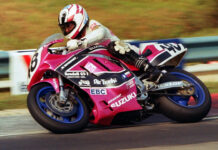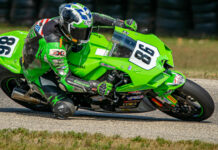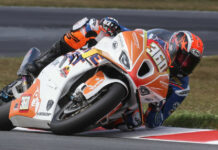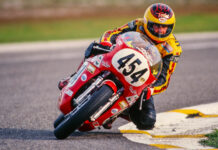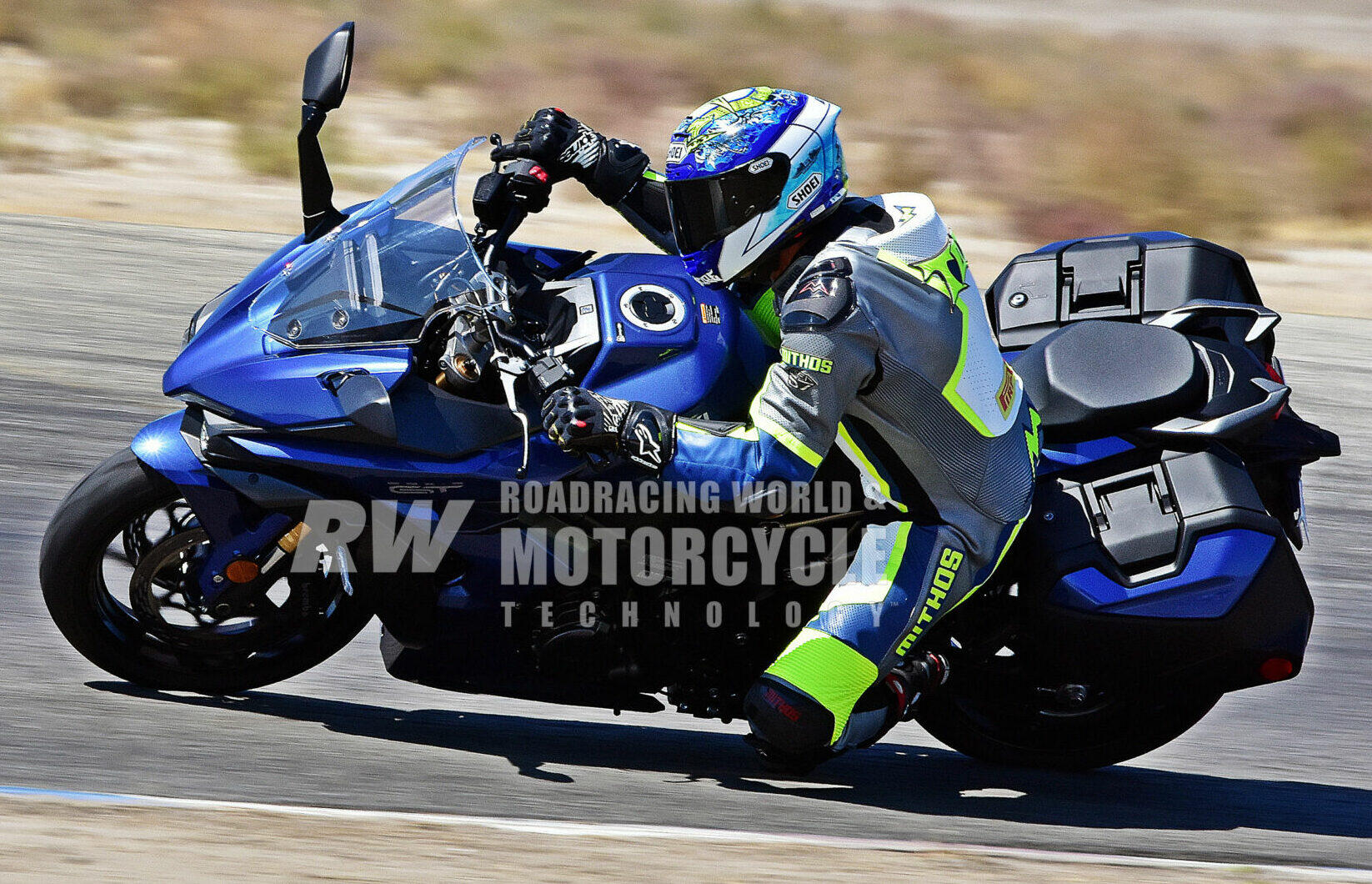Copyright 2022, Roadracing World Publishing, Inc.
Suzuki’s Long-Haul Sport-Tourer (As Originally Seen In The September 2022 Print Issue)
By Michael Gougis
I should have been terrified, but being young and dumb blinds you to things. Case in point: Getting caught in a freezing rainstorm on the Grapevine, a mountain pass connecting Central and Southern California, coming back from one of my first long motorcycle rides. Soaked to the bone, riding a decrepit Honda CB550 with bald tires and a chain and sprocket well past their recycle-bin due date, I was riding on the shoulder, watching semi-trailer rigs splash and slide their way past on my left. There were plenty of ways to die in that moment, and I look back and just shake my head.
I was thinking about that ride on my way to Vancouver, British Columbia, Canada on Suzuki’s sport-touring 2022 GSX-S1000GT+. Getting caught in a downpour in downtown Portland during morning rush hour brought back those memories—the rain dumped down so hard that visibility was nearly nonexistent. I focused on the less-soaked tire tracks left behind by cars, aiming precisely at the center of the left tire’s narrow footprint and focusing on the taillights of the car ahead.
The reason I thought about that earlier ride was the difference between then and what I was experiencing at that moment in Portland. It wasn’t just attire, although an electric vest and a water-resistant, fully armored textile suit meant that I was dry and avoided DCGS (Damp Cold Groin Syndrome).
When the hard rain started, I hit the buttons on the handlebars of the GSX-S, turned the traction control all the way up, and switched to the softest power mode. ABS was already functioning. It would have been difficult to do something with the throttle or brakes that would have caused me to lose traction and fall. So all I had to do was stay on my line, watch the distance to the car in front of me, and ride through the squall. I thought, instead of being soaked, freezing and terrified, I’m mildly annoyed. Irritated that Nature was raining on me, in the Pacific Northwest, of all places!
A good sport-touring motorcycle invites heading for destinations far, far away and delivers the confidence that it can handle anything that happens along the way. Suzuki engineers reoriented and retuned the GSX-S1000F model to expand its touring capabilities and pass new emission standards, adding new ride-by-wire throttle control, electronic rider aids, clutchless shifting, cruise control, a new fairing and hard luggage. And the marketeers renamed it the GSX-S1000GT+.
The sporting capabilities of the prior bike had been solid, albeit weak in the suspension and throttle response. Suzuki upgraded those areas for 2022, but the cargo capacity and cruise control begged to be put to the test. It is an elemental distance machine, a stripper in the world of tourers, squarely in the minimalist, sporty end of the sport-touring segment.
So at 5:27 a.m. one morning, I pulled on my helmet, closed the garage door, jumped on the freeway at the very eastern edge of Los Angeles County and aimed for the Canadian border.
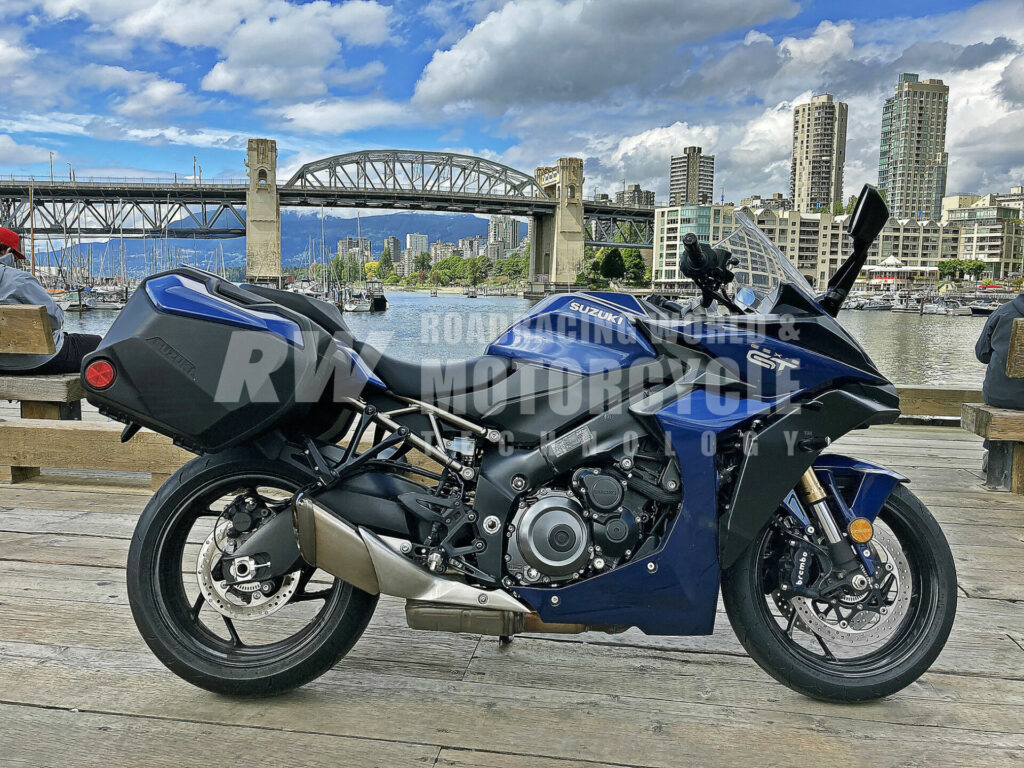
Tech Briefing
Suzuki is making the most of its overhaul of the GSX-S1000 lineup for 2022. Like a chef working from a shelf with only a few spices, Suzuki engineers mixed and matched components, trying to come up with different dishes from a few stock ingredients. Note that the hexagonal LED headlights from the GSX-S1000 naked bike (or ones that are nearly identical) make an appearance in the nose of the GT.
Fortunately, the basic ingredients are good. The engine is the same as used in the new-for-2022 GSX-S1000, an updated version of the 2005-era GSX-R1000 longer-stroke design with a 73.4mm bore and 59mm stroke. New cams, valve springs, cam chain tensioner and cam chain adjuster make up the major internal changes, and this bike shares the naked bike’s new 40mm throttle bodies with 10-hole injectors in each. A new 4-2-1 stainless-steel exhaust has an internal butterfly valve to reduce noise, and since the noise and emissions-reduction equipment is located under the engine, offers the rider the option of replacing the silencer with an approved aftermarket muffler and still meeting the regulations.
Suzuki says the GT model’s powertrain is identical to the one used for the naked bike, and runs on two Dynojet dynomometers bears that out. The naked bike produced 133.09 bhp on the dyno at Mickey Cohen Motorsports (1961 E. Miraloma Ave., Unit B, Placentia, CA 92870, 714-993-5000, www.cohenmotorsports.com). The GT registered 133.69 bhp on the dyno at ChaChaCha Motorsports (393 W. La Cadena Dr. #8, Riverside, CA 92501, 909-684-4600, www.chachachamotorsports.com). That’s a difference of less than ½%.
The transmission has a new assisted slipper clutch and a new clutchless quickshifter for both directions. The new ride-by-wire system is the rider’s main point of interaction with the Suzuki Intelligent Ride System (SIRS), which features the Suzuki Drive Mode Selector (SDMS) with three power modes—Active, Basic and Comfort—and a five-level Suzuki Traction Control System. There’s a low rpm assist system to help prevent stalling when pulling away from a stop, and the machine will start without the clutch lever disengaged if it’s in neutral.
The twin-spar aluminum-alloy frame shares design and dimensions with the GSX-S1000F, the prior faired “comfort” sportbike in Suzuki’s lineup. An older GSX-R1000 swingarm is mated to a single KYB shock adjustable for rebound damping and preload only, with revised valving and spring rates. Because the bike is expected to see two-up use on a regular basis, the GT models have a bespoke subframe and a thicker passenger seat. Front suspension is handled by 43mm KYB inverted forks, adjustable for rebound and compression damping, plus spring preload.
Six-spoke cast aluminum–alloy wheels carry a 190/50ZR-17 Dunlop Roadsport 2 radial at the rear and a 120/70ZR-17 at the front. The ABS brake system operates through four-piston Brembo calipers mated to 310mm (about 12.2-inch) discs at the front and a single 240mm (about 9.5-inch) disc at the rear. New handlebars are wider and closer to the rider, fuel capacity is up to 5.0 gallons, and the rider seat is a touch lower and redesigned as well for greater comfort. Details reflect the motorcycle’s intended mission. The footpegs have rubber inserts where the boots touch. The handlebar is rubber-mounted. Just ahead of that handlebar is a new Thin-Film Transistor (TFT) screen with smart-phone connectivity. Next to that is a power outlet.
The biggest changes from the previous, GSX-S1000F model, are visual. Nearly everyone wanted to call that bike a sport-tourer, so it seems like Suzuki marketeers and engineers threw up their hands and said, “Fine! We’ll make it a sport-tourer.” The new wind-tunnel-designed fairing is all angles and sharp lines, with a hint of MotoGP-inspired winglets thrown in as well. It’s either cutting-edge modern or an homage to the 1980 Craig Vetter Mystery Ship, depending on how you look at it. Honestly, the GT+ sort of reminded me of the way a whole generation went sport-touring back in the day (before people used the term, “back in the day”); they bought Vetter fairings and hard saddlebags, bolted them on to some of the highest-performing bikes available in the showrooms, and chased horizons. It’s like Suzuki took its roadster GSX-S and gave it the Vetter fairing and saddlebag treatment. The “+” in the GT+ nomenclature refers to the inclusion of the 25.7-liter hard bags. An optional higher windscreen is available, also sculpted in the wind tunnel, for those who prefer a larger still-air pocket while riding. Both windscreens allow a controlled bleed of air under the leading edge and into the cockpit, balancing the aero forces on the rider.
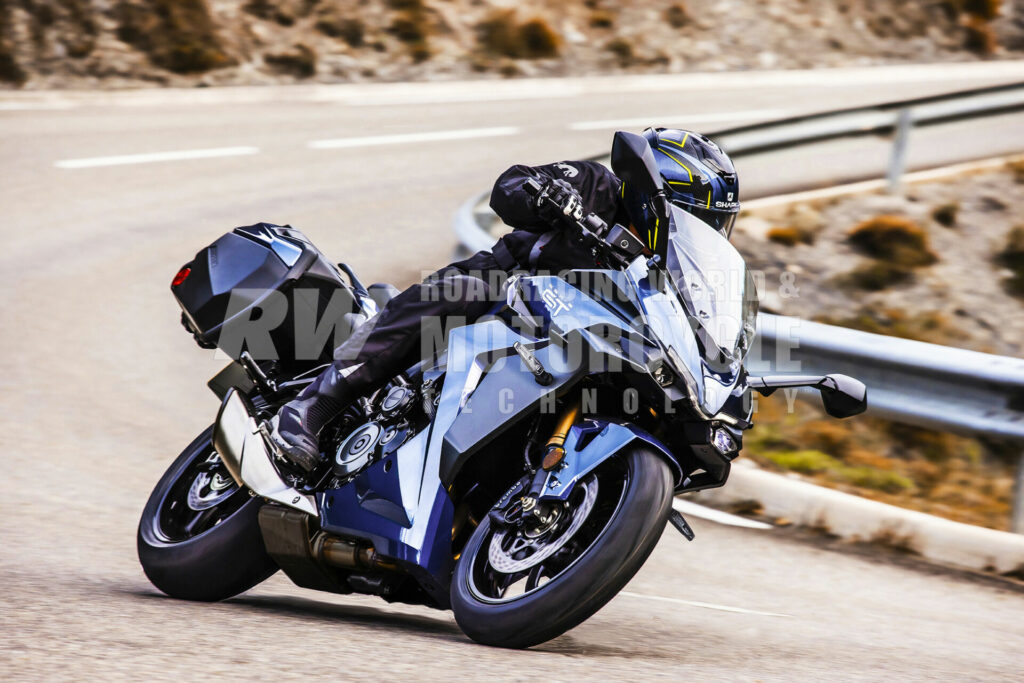
Riding The GXS-S1000GT+
Roadracing World’s customer service admin nicknamed the bike Taylor, after singer Taylor Swift. That’s because when I first rode it to the office, I walked in and asked, “Who sang that song about knowing you were trouble when you first walked in?” From the first few miles I rode the GT+, I knew I was going to put some serious miles on it. With TC set at two and power setting in full party mode, the bike felt powerful, enthusiastic, and fully controllable. I suppose somebody could complain that with “only” 133 bhp pushing 527 lbs., the Suzuki GSX-S1000GT+ is not in the league of true supersport machines, and they’d be right. But there’s a lot to be said for a solid hit of torque from relatively low rpm; a smooth, featureless power curve; and snappy response to the throttle. I left the office with a full-face helmet in one of the saddlebags, confirming that they were spacious and easy to use.
I did a pair of 800-mile days in a week on the bike and followed each of those with 400-mile days. I went through hours of rain; mountain passes with temps down in the low 40s; 100-plus-degree afternoons accented with vicious side winds in the southern part of California; covered miles and miles of empty, straight four-lane Interstate; swept through huge, gentle, and fast corners in northern California and southern Oregon; and braved city traffic in Vancouver, where wandering geese are an ever-present threat. I rode in broad daylight, pitch black of night, and through bug swarms that looked like rain in the headlight beam.
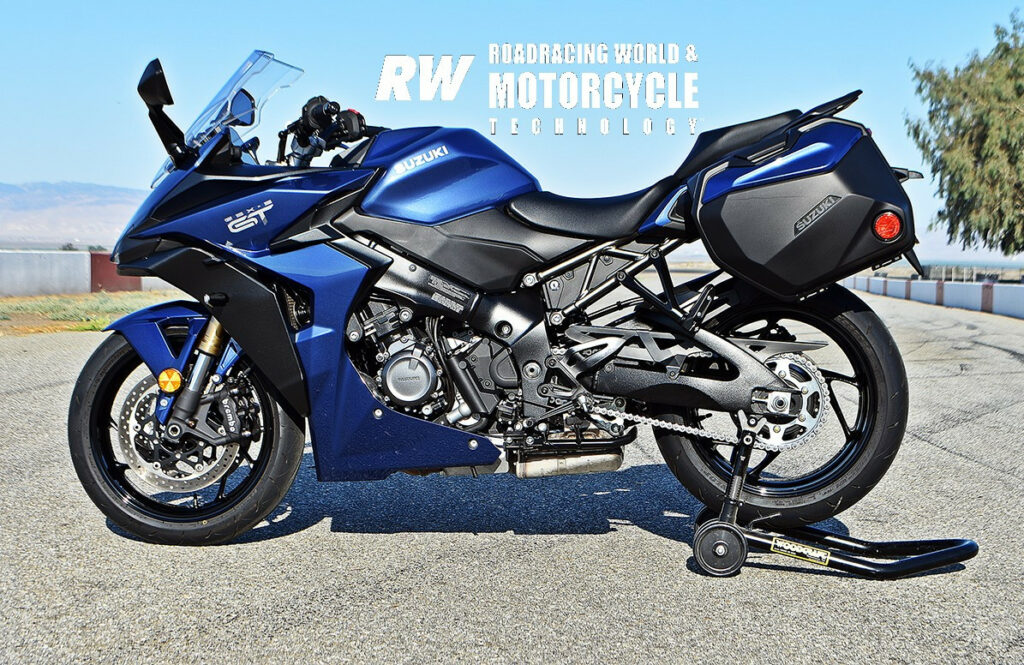
Here’s what got my attention:
I love this engine. Smooth and refined, like an antique piece of furniture that has been lovingly and expertly refinished again and again. It has the power to flatten mountains and pierce headwinds without exertion. Setting the cruise control at 85 mph and pouring on the gas when it came time to pass someone was just something that never got dull; the bike just leaps forward when the throttle is twisted. And even in this type of usage, it got 37 mpg or so, and drafting semi-trucks could bump the real-time mpg display up over 40 mpg for short periods.
The fairing really works for me. I’m about 5′ 10”, and the wind blast hit my shoulders and left my helmet in clean, unbuffeted air. It kept most of the rain off me, and eliminated a great deal of the fatigue that goes along with covering long stretches of road.
The dash lacks some of the features of its competitors (most specifically the Ninja 1000), but the electronic rider aids are simple enough to toggle through. The cruise control holds the vehicle’s speed steady enough, but it’s not as sophisticated as I’ve seen on other brands. Trying to trim off one or two mph made the system feel like it was disengaging fully with the bike decelerating rapidly, as if all power had suddenly been cut. I learned to put my hand on the throttle, feed in a bit of gas from steady-state cruise control operation and disengage cruise by tapping the rear brake pedal. While I’m whining about this merely “adequate” digital cruise control—talk about a first-world problem!—a bike with hard bags that is marketed as a GT machine really needs heated grips.
The seat/bar/footpeg configuration seems perfect for long rides, although I might go for bars that were lower and further forward if I were to use this thing for more sporting rides than long tours. Butt pain was minimal to nonexistent, vibration wasn’t an issue, and the size of the bike wasn’t overwhelming, even in a city setting. It felt nice to have a long-distance machine that delivered feedback more like a sportbike than a cruiser—I felt connected to the motorcycle and the road. And afterwards, really the only pain I felt was in a spot on my back where I was injured in a car wreck decades ago—and it hurts during short rides on some bikes!
A lot of the comfort came from Suzuki and KYB engineers tweaking the suspension settings. The GSX-S1000F, as mentioned, was a wonderful concept let down by a shock that seemed to come out of the reject pile at a bargain shock factory. The new suspension is So. Much. Better.
Things were still a bit vague if I just kind of eased the bike into a corner, but when I dialed in more damping at the rear and then threw the bike over with authority and confidence, it responded with stability and precision. And this version no longer beat me up on the freeway or city streets.
I’m still in the kind of shape where taking a GSX-R1000 from LA to Laguna and back doesn’t faze me. So I wanted to put the GSX-S1000GT+ to the sort of test that I wouldn’t necessarily want to do on a full-blooded sportbike. The bike behaved flawlessly, handled well, rode comfortably, and did everything I wanted it to do—which was haul ass for a long distance and get up and do it again the next day. Compared to its closest competitor, the Ninja 1000, the Suzuki is a bit less sophisticated in the dash, a little more raw. But it’s also about 12 horsepower stronger, about 14 pounds lighter, and the chassis feels stiffer and more connected to the pavement. The Yamaha Tracer 9 GT is another potential competitor, with active suspension, an excellent chassis, and very nice heated grips. But it’s down about 25 horsepower to the Suzuki, and its lighter weight can’t make up the difference.
In the sport-touring universe, the GSX-S1000GT+ is relatively light, powerful, solid, and comfortable. A good sport-touring bike is a balanced compromise, and in this case, after a long courtship, it feels like Suzuki engineers got the recipe almost perfect for me.
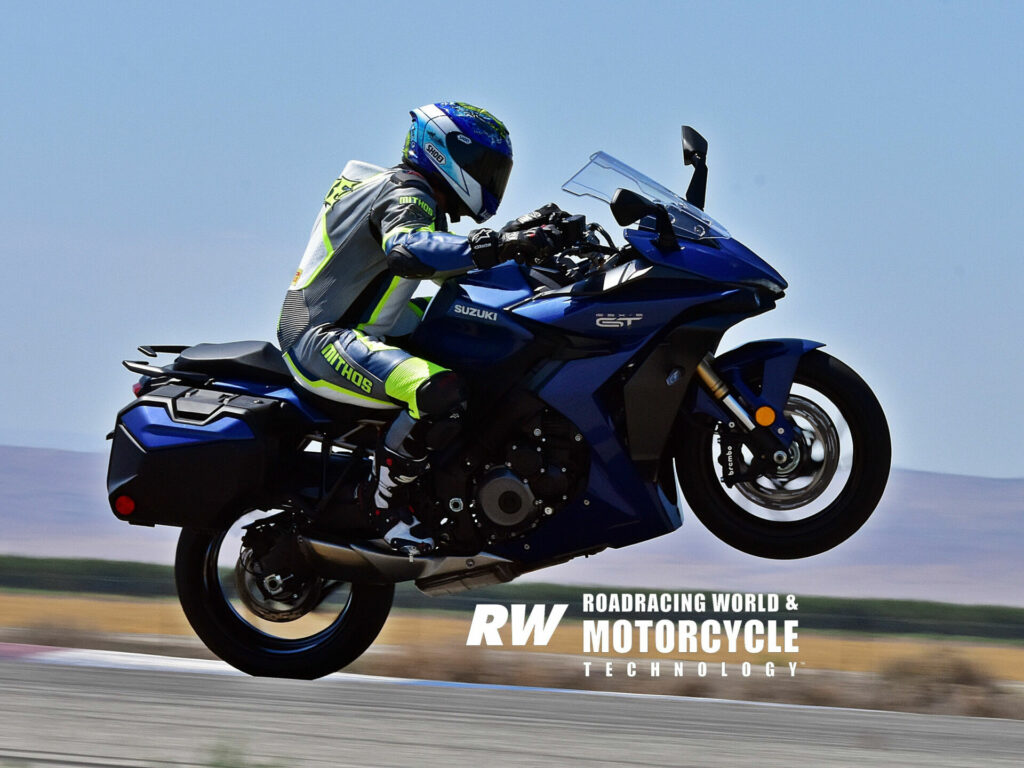
Riding On The Track
Long-time Pro racer Jeremy Toye spent a hot summer morning ripping the GSX-S1000GT+ around the 3.0-mile circuit at Buttonwillow Raceway Park. While machines with saddlebags are not his typical choice for track use, Toye still found plenty of positive things to say about the sportbike in touring clothes.
“It gets the job done, it really does. The biggest drawback is the suspension. It’s really soft. But I was putting load into the shock before I would get to the corner, and that way it didn’t lock up or hit the limits of the linkage. And honestly, the chassis is so good that it makes up for a lot of the suspension behavior. I could really put a lot of force into the front end, and I can tell the geometry is kind of raked out, but it still works. Brakes were good, power was good for what it is, even the tires were not bad – I had fun.”
Toye isn’t the kind of rider who just hangs around, no matter what the machine. There are bumps in the final corner of Buttonwillow that some refer to as a launch ramp. Other riders slow down. Toye described his approach to the corner as “apex early, get the thing upright, and when it jumped up I could hear the forks top out as the front end came off the ground.”
And although it isn’t a cutting-edge sportbike, Toye still found that on the racetrack, Suzuki’s approach of using tried and tested components, refined over years, paid off with a bike that kept its composure in an environment well wide of its design brief.
Specifications: 2022 Suzuki GSX-S1000GT+
Engine Configuration: Four-stroke Inline-4
Engine Displacement: 999cc
Engine Cooling: Liquid
Compression Ratio: 12.2:1
Combustion Chamber Design: Pentroof
Valves Per Cylinder: 4
Intake Valves Per Cylinder (Material): 2 (Steel)
Exhaust Valves Per Cylinder (Material): 2 (Steel)
Bore and Stroke: 73.4mm x 59.0mm
Connecting Rod Length (center-to-center): 4.5 inches (111mm)
Connecting Rod Material: Steel
Measured Peak Horsepower: 133.69 bhp @ 10,230 rpm
Measured Peak Torque: 72.15 lbs.-ft. @ 9,030 rpm
Engine Redline: 11,700 rpm
Valve Angle Intake/Exhaust (Included): 12 degrees/13 degrees (25 degrees)
Valve Adjustment Interval: 15,000 miles (24,000 km)
Intake Valve Diameter: 30.0mm
Exhaust Valve Diameter: 24.0mm
Intake Valve Stem Diameter: 4.5mm
Exhaust Valve Stem Diameter: 4.5mm
Intake Valve Maximum Lift: 8.5mm
Exhaust Valve Maximum Lift: 8.3mm
Intake Valve Timing:
Open BTDC: -2 degrees
Closed ABDC: 46 degrees
Duration: 224 degrees
Lobe Centers: 110 degrees
Exhaust Valve Timing:
Open BBDC: 40 degrees
Closed ATDC: 0 degrees
Duration: 220 degrees
Lobe Centers: 110 degrees
Valve Timing Measurement Point (lift): 1.0mm
Throttle Body Venturi Size: 40mm
Air Filter Type (material): Pleated Paper
Exhaust System Type (Material): 4-2-1, Stainless Steel
Ignition System: Digital
Electronic Rider Aids:
Power Modes: Three – Active, Basic, Comfort
Traction Control: Yes (Five Levels)
ABS: Yes
Engine Braking: No
Slide Control: No
Wheelie Control: No
Launch Control: No
Hill Start Control: Low-rpm Assist
Reverse: No
Electronic Quickshifter: Yes, Up/Down
Lubrication System: Wet Sump
Oil Capacity: 3.6 quarts (3.4 liters)
Fuel Capacity: 5.0 gallons (18.9 liters)
Transmission Type: 6-Speed, Constant Mesh
Clutch Type: Wet, Multi-Plate, Assist/Slipper
Clutch Actuation System: Cable
Clutch Spring Type: Coil
Number Of Clutch Springs: 3
Number Of Clutch Plates: 19
Driven: 10
Drive: 9
Primary Drive: Gear (Straight Cut)
Primary Drive Gear Teeth (Ratio): 73/47 (1.553:1)
Final Drive Sprocket Teeth (Ratio): 44/17 (2.588:1)
Transmission Gear Teeth (Ratio):
6th: (33/26) 1.269:1
5th: (34/25) 1.360:1
4th: (26/24) 1.500:1
3rd: (36/21) 1.714:1
2nd: (39/19) 2.052:1
1st: (41/16) 2.562:1
Transmission Overall Ratios:
6th: 3.167:1
5th: 5.465:1
4th: 6.163:1
3rd: 6.888:1
2nd: 8.247:1
1st: 10.297:1
Theoretical Speed In Gears At Redline:
6th: 167 mph
5th: 156 mph
4th: 141 mph
3rd: 124 mph
2nd: 103 mph
1st: 83 mph
Engine Speed At 60 mph: 4,220 rpm
Frame Design (Material): Twin-spar, Aluminum
Rake/Trail: 25.0 degrees/3.9 inches (100 mm)
Claimed Wheelbase: 57.5 inches (1,460 mm)
Measured Swingarm Length: 23.2 inches (592 mm)
Seat Height: 31.9 inches (810 mm)
Footpeg Height: 13.2 inches (335 mm)
Handlebar Height: 37.5 inches (952 mm)
Steering Stem to Seat Center: 22.5 inches (572 mm)
Front Forks: KYB, inverted
Fork Tube Diameter: 43mm
Fork Adjustments:
Rebound Damping: 14 Positions (clicks)
Compression Damping: 3 Positions (clicks)
Spring Preload: 10mm
Front Wheel Travel 4.7 inches (120mm)
Rear Wheel Travel 5.1 inches (130mm)
Rear Suspension Type: KYB Single Shock
Rear Shock Adjustments:
Rebound Damping: 3.0-Turn Range
Compression Damping: Non-adjustable
Spring Preload: Seven-position Ramp Adjuster
Front Brakes: Dual 310mm (12.2-inch) Discs, 4-piston Radial-mount Brembo Caliper
Rear Brake: Single 240mm (9.5-inch) disc, Single-piston Nissin Caliper
Front Wheel (material): 3.50 x 17-inches, 6-spoke (Cast Aluminum)
Rear Wheel (material): 6.00 x 17-inches, 6-poke (Cast Aluminum)
Front Tire: 120/70ZR-17 Dunlop Roadsport 2 Radial
Rear Tire: 190/50ZR-17 Dunlop Roadsport 2 Radial
Wet Weight: 527 pounds (239 kg)
Weight Distribution (F/R): 51%/49%
GVWR: 926 Pounds (420 kg)
Overall Length: 84.3 Inches (2,141mm)
Overall Width: 32.5 inches (825mm)
Overall Height: 47.8 inches (1,214mm)
Ground Clearance: 5.5 inches (140mm)
Suggested Retail Price: $13,799


